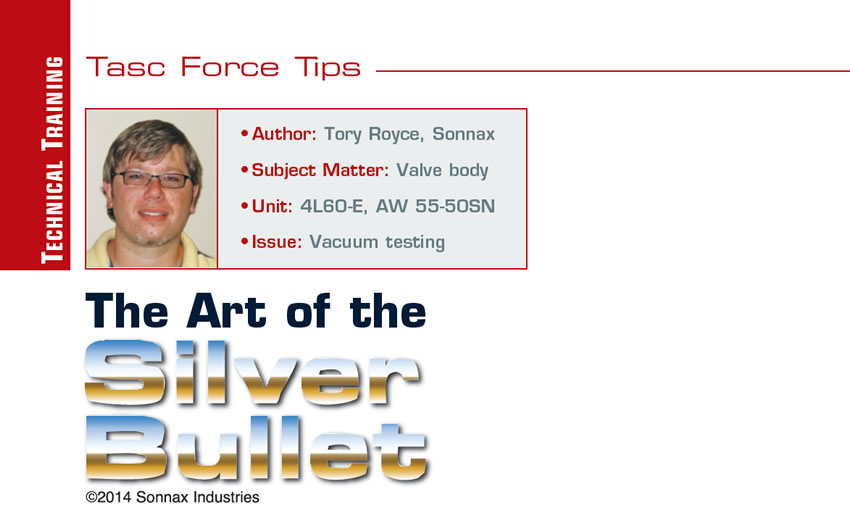
TASC Force Tips
- Author: Tory Royce, Sonnax
- Subject Matter: Valve body
- Unit: 4L60-E, AW 55-50SN
- Issue: Vacuum testing
From the TASC Force we reprint a series of in-depth test instructions for checking the serviceability of valve bodies. ©2014 Sonnax Industries
Folklore has it that bullets cast from silver are the most effective means of dispatching werewolves, witches and vampires. Ever have one of those dreams where you conquer the bad guy and save the world? While this is possible in the fantasy realm, silver bullets don’t always provide heroic results in the real world, where many problems need to be solved with brains, not blind luck.
We all want to be the hero, and sometimes finding solutions to obstacles can be a real headache. Most people will choose the path of least resistance to keep things simple, and one of the more common traps technicians can fall into is relying on “Silver Bullet Diagnosis” when troubleshooting transmissions. It’s easy to assume that, because we’ve seen a symptom several times, the correction will always be the same. It’s equally tempting to ask other technicians what “silver bullets” they might have in their bandoleer when it comes to a showdown with an unfamiliar problem. Time is money – it would be great if every problem could be fixed with a canned solution – but that may not be the best approach.
A perfect example of this is dealing with the notorious P1870 or P0894 codes in 4L60-E units. The root cause is always excess wear in the TCC regulator bore, right? The majority of the time, this silver bullet diagnosis hits the mark, but on many occasions this assumption has backfired on unsuspecting technicians. The thing to remember about these particular codes is that they denote excess “component slippage,” not necessarily TCC slippage. While less common, internal unit clutch slippage also can trigger these codes, so the technician must first establish if the slip is even related to the converter. A simple test drive with a scan tool on board to monitor TCC-apply duty cycle and slip speed is usually all it takes to pinpoint where the slippage is taking place.

If excess converter slip is confirmed, the regulator bore should not be the only part of the circuit that gets attention. Other components in the TCC circuit must be studied closely during the build to avoid comebacks. Beside regulator bore wear, some other common items which can cause TCC slippage include:
- TCC apply valve in pump
- TCC solenoid(s)
- Worn stator support bushings
- Turbine shaft checkball damage
- Internal converter issues
- Electronic malfunctions
With all these variables, anyone who attempts to blindly fire a silver bullet into the TCC regulator bore is destined eventually to miss the real target, costing themselves time, money, frustration and their shop’s reputation when the bullet ricochets.
Every transmission model on the road has at least one similar story. For example, Aisin AW 55-50SN units can develop harsh, erratic shifting as unit operating temperature increases. In this case, the linear solenoids are the target. Pintle bushing problems within the solenoid assemblies have plagued this transmission since its inception, and many builders assume a set of linear solenoids will be the magic fairy dust that cures all problems. In many cases, this approach will work in getting the unit out the door, but ignoring valve body bore wear can have consequences in the long term. Vacuum testing will help identify common wear issues in the casting and is the best defense against an unwanted comeback. Areas of particular concern include:
- Solenoid modulator valve
- Secondary regulator valve
- Lockup relay and control valves
- Pressure regulator and boost valves
- LPC accumulator piston bore
- Loose bore end plugs
These examples show how easily off-the-cuff diagnosis can end in a comeback or a unit that never leaves the shop. The reality is that concrete diagnostic steps must be taken to effectively pinpoint the cause of a problem before a solution can be devised. Skipping these steps in favor of the ill-advised silver bullet eventually will burn even the luckiest person by coming back around to hit where it hurts most: the wallet. A little extra time spent on testing and diagnosis will guarantee a complete, proper repair and more importantly, a happy customer with a new hero.

Tory Royce is a Sonnax technical support specialist and a member of the Sonnax TASC Force (Technical Automotive Specialties Committee), a group of recognized industry technical specialists, transmission rebuilders and Sonnax Industries, Inc. technicians.













